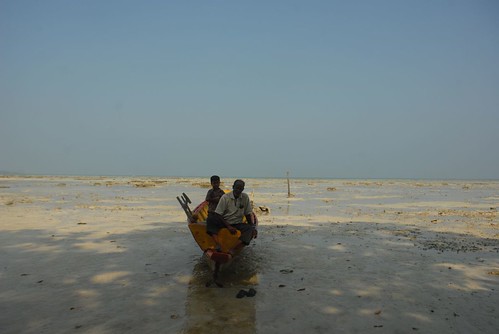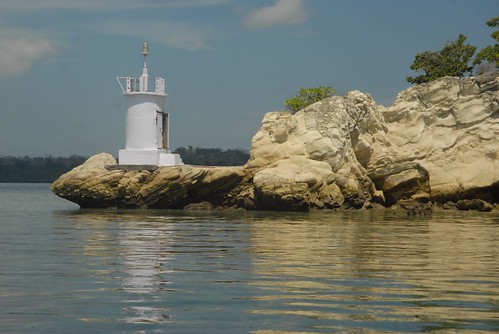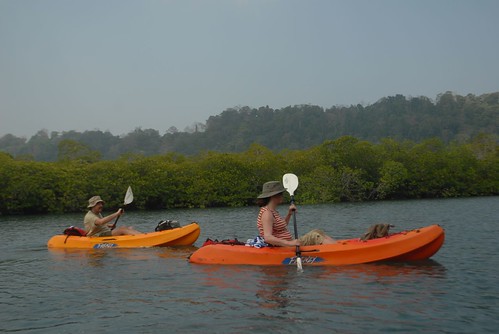
Getting to Havelock Island is hard work. But perhaps there is something to say for the length of the journey. With every stage of the travel, you move a step away from the rapidity of life in Mumbai, and a step closer to the mildness of life in the islands.
Which is not to say that there is no adventure to be had; or that the life on the islands is idyllic. Far from it. Havelock is the centre of all scuba diving activities in the Andaman & Nicobar islands. It is also a place where the coming of tourism has created an uneasy tension for the local population.
Three-way street
It takes two flights and a ferry, and costs approximately Rs 10,000 to reach Havelock. It is a small island with a triumvirate of roads that meet at a tiny little roundabout at the Market. One runs down from the jetty; one will take you to Radhanagar beach, the island’s most popular seaside spot; and the third that comes from Kalapathar is lined with resorts both cheap and expensive, offering log huts with varying degrees of comfort.
The ferry to Port Blair is the lifeline of the island, and its only link with the other islands littered around it in the Andaman Sea. There is a helicopter service, but its schedule is more unpredictable than the moods of the sea.
Which are many. The thing about being on a small island is that you can get from the windward side to the leeward in a matter of minutes. At one end, the water is calmer than any swimming pool in Bombay. A warm, shallow blue-green, just meant for paddling and splashing about, perfect for a morning swim when you’re not still quite awake.
As you travel along the island’s coast, the colours change with alacrity, turning into a deep blue as you get close to Radhanagar. The water there is edged in white; the surf of strong waves that will pick you up and toss you closer to shore. A swim there is like an ayurvedic massage, pillow fight and kickboxing session rolled into one. You always emerge battle-weary, yet somehow refreshed and happy.

Meandering about town
The jetty and the Vijaynagar crossroad where the triumvirate roads of Havelock meet, are the two centres of activity in Havelock. The beaches and villages on the island are numbered, though in a manner of numbering that is conclusively Indian. Beach number 7 follows Village number 2 and 4 in tempestuous confusion. Most of the residents of the islands are Bangladeshi refugees brought there by the Indian government. Turns out that the villages were numbered in the order in which they were settled, which is why Beach 5 is on a different road from Village 4. They acquired names much later.
Along the beaches, all the land has been sold to resort companies, some of the more recent sales made at preposterous prices. But if you rent a motorcycle and go around riding the smaller offshoots of the main roads, you’ll find that away from the tourism and the beaches, farming still continues in the interior of the island.
Aimless riding around and exploring is one of the main activities on the island. With two litres of petrol in the tank, you have enough fuel to travel the length and the breadth of the island several times over. Many a day is well spent looking for the next likeliest spot for a swim; what other decision is of greater importance?
Just rent a set of snorkels as well. The water around the Andamans is rich and full of life. From nearly every beach and swimming spot there is an easily accessible bit of reef where you can easily spot shy clownfish peeping among the anemones. You can also rent a boat to go snorkelling at a further away spot. It’s something you can try even if you can’t swim because most boatmen give you a floating device and throw you a line; secured to those you can merrily bob around, looking into the water. Just remember to put loads of sunscreen on the back of your legs.

A more energetic holiday
If you’re looking for something a bit more energetic, sign up for a scuba diving course.
There are two kinds of holidays that can be had on Havelock. One is the restful ‘do nothing’ sort I’ve described so far, where you spend you time swimming, chasing the perfect spot of shade on the beach and snoozing in it, and sipping coconut water as you read your book and wait for the sunset.
This is not the holiday you will have if you sign up for scuba diving, but you will not regret it. For the first day-and-a-half of the course, you will feel like you’re back in school, learning the theory of the equipment that helps you survive underwater, and then performing exercises with it that help you deal with possible emergencies. The hard work done, you’ll spend the other two days with your eyes wide open for the most time, as you navigate a completely different world, with its own set of rules and full of so many hundreds of beautiful things. At no point during these four days will you have time for anything other than scuba diving, big meals, and very sound sleep.
Havelock is a small place that even during peak season may seem rather empty and bare to you. But often, during this time, the resorts take turns organising little parties every night, to which all are welcome. There will be music, sometimes even a live band and dancing. In the distance, there will be the moon presiding over a dark sea.
It was at one such party that I spoke to some of the resort and dive shop owners who have made Havelock their home. Tourism and their presence has brought good things to the island; but also wrought changes that no one fully understands. There is more money, but no land, few jobs, and exposure to a way of life that is unfamiliar. But the people and the place still retain the original charm and innocence. It is a place where tourism has come slowly and without the big restaurants, shacks, casinos and discotheques that are the mark of a busy seaside holiday spot. Neither is it a place that has room for these. Don’t go there looking for a cleaner Goa; that is one kind of holiday you will not find in Havelock.

A version of this was published in the Hindustan Times in January.








